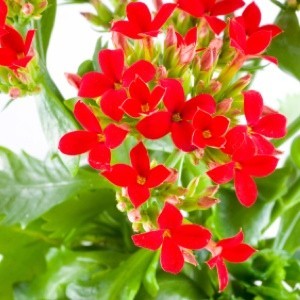If you are looking for a practical alternative to traditional holiday poinsettias, then flowering kalanchoes may be worth considering. Over the past few years, these happy little succulents have enjoyed a steady gain in popularity as houseplants and Christmas-flowering gift plants, and it's easy to see why. Kalanchoes are easy to care for, come in a variety of festive colors, and offer a long-lasting supply of blooms-from 6 to 8 weeks or longer.
Some types of kalanchoes are grown for their foliage, while others are grown for their flowers. For the purposes of this article, I'm going to be referring only to those types that are grown for their flowers.
Flowering kalanchoes are divided into two basic types: Kalanchoe blossfeldiana and K. manginii hybrids. Of the two, K. blossfeldiana is by far the more popular of the two, and is the type that growers are able to coax into flowering at any time of the year. They come in two sizes: standard (1-1.5 ft high) and miniature (6 inches high), and in a variety of colors including white, yellow, salmon, orange, purple, pink, and red. These compact, bushy plants are easy to distinguish from other holiday plants. Look for plump 2-inch glossy leaves under umbrella-shaped flower heads containing 20-50 tubular blooms.
When received as gifts, kalanchoes are often thrown away after flowering. With the proper care, it is possible to keep them all year long and coax them to flower again.
Similar to poinsettias and Christmas cacti, kalanchoes require shorter days for flowers to develop. Commercial growers fool the plants into flowering by covering them with special shades for 14 hours each day until they form buds. You can accomplish the same thing at home using a simple cardboard box or by placing the plant in a dark closet. Plan to keep the plants in total darkness for 14 hours each day until the flower buds form (about 5-6 weeks), and expect to see flowers about three months after your start this "short day" treatment. For holiday blooms, plan to start a "short day" treatment in early to mid September.
In the spring, when danger of frost has passed, kalachoes can be planted outdoors in your garden in light shade. Plants that become leggy can be cut back to half their size to encourage a more compact form.

About The Author: Ellen Brown is an environmental writer and photographer and the owner of Sustainable Media, an environmental media company that specializes in helping businesses and organizations promote eco-friendly products and services. Contact her on the web at http://www.sustainable-media.com
Add your voice! Click below to comment. ThriftyFun is powered by your wisdom!
I also applaud these plants that bloom during the holiday season. I have several, at least two of which bloom with red blossoms. These look especially festive when paired with something that carries white flowers.
Add your voice! Click below to comment. ThriftyFun is powered by your wisdom!